January 26, 2023 – Volume 25, Issue 1
In This Issue
- Flanigan’s Eco-Logic: The Power of the Sun
- SAF – Sustainable Aviation Fuel
- Hydrogen-Powered Planes
- UGES
- Electric Vehicle Updates
- Floating Offshore Wind Shot
- Cigarette-But Accountability
- Flanigan’s Ego-Logic Podcast Updates

Flanigan’s Eco-Logic: The Power of the Sun
Let’s talk about 5% and the vast solar potential that will power our future!
Solar energy has just topped 5% of electricity generation in the United States. That’s a good step. The Energy Information Administration (EIA) of the U.S. Department of Energy, produces detailed monthly and annual reports. The final 2022 issue of Electric Power Monthly covers the first ten months of 2022. During that time frame, renewables – made up of biomass, geothermal, hydropower, solar, and wind – provided 22.6% of the nation’s electricity. Renewables out-produced both coal and nuclear.
Renewable electricity generation increased by 14.26%. This compares to all other forms of power generation combined which increased by 3.14%. Wind increased by 16.86%; geothermal by 6.45%. Large and small-scale solar systems are included in the data. All forms of solar increased by 26.23%, raising solar’s share of the national total to just above 5%… 5.05% as reported by EIA. Growing yes, but still paltry when compared to the potential of the sun.

We’ve all heard this: There’s as much solar energy striking the Earth every hour as is consumed by all humans worldwide in a year. The potential is huge: 430 quintillion joules of incoming energy in an hour versus 410 quintillion joules used by humanity throughout the entire year. So 5.05% feels like we’re just scratching the surface of solar’s potential.
The sun abounds and provides free energy. It just needs to be captured. Where to do so? On rooftops of our homes, businesses, and schools, and utility-scale systems in the desert. EcoMotion says… all of the above! The U.S. DOE notes that with the falling prices of solar, solar PV will account for 33% of U.S. generation by 2050. That’s good. Clearly we have a lot of headroom… a lot of solar to deploy to get from five to 33%.

There is huge potential for solar, on rooftops, carports, and in ground-mount configurations. A National Renewable Energy Laboratory (NREL) study focused on the solar potential from rooftop solar on low-to-moderate income households. Of the 116.9 million households analyzed for orientation and shading, 67.2 million were deemed suitable for solar, able to generate nearly 1,000 TWh annually. That’s a fourth of our nation’s annual consumption.
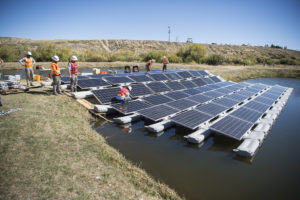
Then there is solar in unusual places… like “floatovoltaics,” floating systems that have been deployed in Asia as well as Kenya, and the Maldives powering an idyllic resort. Some ventures are working to put solar arrays in space, then beaming power to Earth. Years ago I met the Brusaws. Julie and Scott are Idaho-based and have a company called Solar Roadways. Its mission is to incorporate solar into roadways. And the potential is huge! Their prototype roadway materials and systems – supported by government grants – are able to withstand the pressure of fully loaded semis rolling over them.

Solar Roadways envisions that all surfaces that are walked upon and driven upon, can be put to use as power plants. This includes city streets, highways, parking lots, driveways, tarmacs, plazas, bike paths, and more. Solar Roadways suggests that if every walkable and driveable surface were paved with their embedded panels, the resulting power output would be three times the power generation requirement of the entire country.
There are lots of opportunities for solar and means to get beyond 5% by an order of magnitude. My great friend Michael Totten posted an Energy Brain Trust item that reminds us of the potential of solar in transmission rights of ways. These are unused land areas that are often well suited for power generation, given the link to transmission. Fully flexing that strategy would fulfill 20% of the nation’s annual consumption. Let’s back into this finding:
In 2011, the Institute for Local Self Reliance calculated that there are 155,000 miles of high voltage transmission lines in the United States. The study assumed 150-foot rights of way, and that only half of the area could be used for solar. Based on an assumed 275 MW of solar potential per square mile, there would be enough room for 600,000 MW of capacity. Cincinnati’s solar insolation was used as a proxy value for the country, resulting in 720 billion kWh of transmission-corridor solar potential.
At EcoMotion, we envision a solar/hydrogen future. We envision solar in all the configurations discussed, and with an equal number of ownership models. We’re proud to be part of the solar movement, tapping the vast power of the sun, for a sustainable future. Do we have enough carbon-free energy? There is no question that the answer is strongly affirmative!
Quotes of the Month:
“It’s the last remaining acceptable form of littering. People are more likely to pick up their dog poop than cigarette butts.”
Tom Novotny, Epidemiologist, San Diego State University
“I think youngsters need to start thinking about what kind of a world they are going to leave for me and Keith Richards.”
Willie Nelson
SAF – Sustainable Aviation Fuel

Image Courtesy of Greenaironline.com
SAF is a biofuel used to power aircraft. It is produced from sustainable feedstocks and has very similar chemistry to traditional fossil jet fuel. SAF is produced from a variety of sources… from forest and agricultural wastes, to used cooking oil, carbon captured from the air, and green hydrogen. SAF does produce CO2 but is considered neutral as it balances the carbon emissions produced during flight with the carbon absorbed during production.
Early this month, GE Aerospace made aviation news by “ground testing” a Boeing 787-10 engine with 100% sustainable fuel. GE has been in a race with Rolls Royce to develop an engine that can run completely on SAF. Rolls Royce – with Boeing and Virgin Atlantic – have committed to having a Dreamliner operating solely on SAF traversing the Atlantic as soon as next year.

In 1974, Safran Aircraft Engines – a French company – partnered with GE Aviation to form CFM International to develop aircraft engines. CFM is the exclusive supplier for Boeing’s 737 MAX jets. More recently, the engines have been tooled to run on sustainable aviation fuels.
In 2021, GE and Safran developed the LEAP 1B engine. It powered the first commercial flight with SAF in one engine. That was aboard a United Airlines Boeing 737 MAX traveling from Chicago’s O’Hare to Reagan National Airport in Washington D.C. An Alaska Airlines 737 MAX 9 also tested 100% SAF in one of its LEAP 1B engines. That flight was done in partnership with NASA to measure engine particle and trace gas emissions over different thrust settings and comparing different percentages of SAF and jet fuel.
Several airlines today are running with blends of SAF, including Alaska, American, JetBlue Airways, and Japan’s largest airline, All Nippon Airways. Their engines are capable of running on 100% SAF. But regulators will dictate how fast 100% SAF goes commercial: They need to be satisfied that a pure sustainable aviation fuel blend will be entirely failsafe before increasing its 50% SAF blend allowance.
Hydrogen-Powered Planes

Image Courtesy of Airbus
Hydrogen is in focus for aviation: There are two forms of its use in aviation. First, is using combustion jet engines burning liquid hydrogen fuel. Second is using fuel cell battery systems fueled by gaseous hydrogen. While very early to make such a proclamation, it appears that the first form may be used for medium and later long-haul routes, and the second – the Electric Plane (EP) option – will likely begin to be deployed with short-haul routes.
Let’s begin with the first configuration: Airbus has announced that it is planning to design, build, and demonstrate a “megawatt-class propulsion system” for large-scale passenger aircraft. It will use hydrogen fuel cell technology backed up with cryogenic hydrogen storage at -253 degrees Celsius… in four years! There are still challenges. Notably, the planes will have to carry four times as many liters of jet fuel, as the liquid hydrogen is not nearly as dense.
The EP option is progressing on many fronts. Big news from England: A 19-seater plane has successfully used hydrogen to power a fuel cell to power a propeller. Supported by the United Kingdom’s HyFlyer II project, in a test flight in England, a Dornier 223 successfully tested hydrogen in one of its two engines, the other powered by conventional fuels.

Image Courtesy of ZeroAvia/Kate Barabanova
UGES

UGES stands for Underground Gravity Energy Storage. It’s a technology that envisions the utilization of abandoned mines for power production. According to research conducted by the International Institute for Applied Systems Analysis Energy, Climate, and Environment Program, there are millions of abandoned mines globally. There are 550,000 in the United States, 50,000 in Australia, and 10,000 in Canada. Researchers believe that there is a global potential of some 70 TWh from UGES. Most of this is in China, India, Russia, and the United States.
So we welcome a novel way to store energy using defunct mines. Yes, in some cases the mines are toxic and unusable. But researchers consider many of the mines to be great assets for storage. The basic infrastructure is in place for power production; they are connected to the power grid. At some sites, there is mining equipment in place that could be repurposed to handle the sand… dump trucks, conveyors, and booms.
There are basic components to the technology: the shaft, upper and lower storage sites, and the generator. It works by lowering sand into a mine when the price of electricity is high, the descent controlled by regenerative braking. The sand is later lifted when electricity is cheap. Unlike batteries, sand has no storage degradation.
UGES is a subset of “solid gravitational energy storage,” a technology made most vivid by Energy Vault that stacks and later lowers concrete blocks during peak periods. Other forms of gravitational energy storage include use of abandoned train tracks on grades to raise and lower materials for power production.
Electric Vehicle Updates
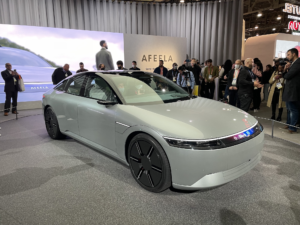
Sony: Sony is about to sell electric vehicles… well, in 2026! Four years in a row it has brought its electric car prototype to the Consumer Electronics Show (CES), to show it off to a global audience. Now the prototype has a name – AFEELA. And a production date? Pre-orders will be taken in the first half of 2025, then shipments are planned for the spring of 2026. Sony believes that its entertainment and software expertise will allow it to provide a better in-car connected experience than traditional automakers. It has formed a partnership with Honda called Sony Honda Mobility Inc.
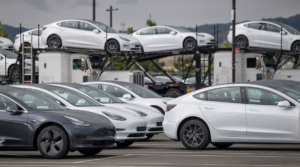
Tesla: Last month, we reported on BYD becoming the world’s largest electric vehicle maker. This month we report that Tesla has outpaced VW in 2022 to be Germany’s top EV seller. Tesla sold 69,963 vehicles in 2022; VW sold 63,206 EVs. EVs are now 17.7% of the new car market in Germany, a 30.1% increase over 2021 values. Thanks to local production at Giga Berlin, Tesla’s discounted prices in the final months of 2022 drove up sales.

Hertz: Hertz car rentals is ramping up its EV program in earnest with the commitment to buy 5,200 electric vehicles to serve Denver Colorado. The “Hertz Electrifies” program will support rental customers as well as ride-share drivers. Hertz will also be installing chargers at Denver International Airport and other Hertz locations in Denver. The rental agency will also support the build out of EV charging infrastructure. Mayor Michael B. Hancock sees this as an important step in Denver’s quest to reduce carbon emissions by 80% by 2050.
Hertz has certainly been an EV leader. In 2022, it ordered 100,000 Teslas. Later it ordered another 175,000 EVs from General Motors, and then 65,000 from Polestar… forming an impressive fleet of 340,000 EVs. Its goal is to create economic and environmental benefits for communities by forming partnerships with mayors across the United States. Together, Hertz and the city leaders will support youth internships and training opportunities, and will “share telematics from its fleet of connected cars to help inform public charging infrastructure planning.”
Hertz and Uber continue their EV partnership. Uber has made a commitment to be a zero emissions platform by 2030 in the U.S. and in Europe. In North America, Hertz has leased ~50,000 EVs to Uber drivers to date. This has resulted in 24 million fully-electric trips and 260 million miles. Now Hertz will provide 250,000 EVs in Europe by 2025, EVs including Teslas and Polestars.
Floating Offshore Wind Shot
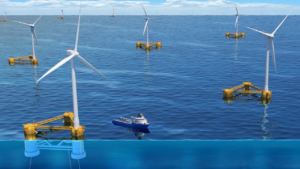
Image Courtesy of NREL
Offshore wind is considered to be America’s next big energy source. The National Renewable Energy laboratory (NREL) estimates that there is 4,200 GW of capacity which could generate 13,500 TWh of electricity annually. That compares with total U.S. electricity consumption in 2021 of 3,930 TWh. Offshore wind’s potential is 4X current U.S. consumption.
Floating wind turbines represent two-thirds of the offshore wind potential in the United States, ~2.8 TW of capacity… double the rate of current U.S. consumption. Floating turbines will be located in waters too deep for fixed-bottom installations. “Floaters” are anchored to the seabed using mooring lines.
The United States Department of Energy developed the Energy Earthshots initiatives to accelerate breakthroughs to more affordable clean energy. In 2022, the DOE announced the latest Earthshot initiative, the Floating Offshore Wind Shot. Its goal is to drive down costs by 70% by 2025, thereby providing cost-competitive $45/MWh power. Its goal is also to deploy 15 GW of floating wind by 2035. Backing the initiative is $50 million to support a variety of research initiatives.
This month’s news is a Floating Offshore Wind Shot Summit that will convene multiple stakeholders. Hosted by four departments – Energy, Interior, Commerce, and Transportation – the virtual summit on February 22 – 23 is for policymakers, experts, community leaders, and innovators. The idea is to bring parties together to lay out a shared vision, and to overcome technical, social equity, and environmental challenges, including tribal lands, fishing, and seafaring issues.
Cigarette-But Accountability

Cigarette butts are one of the most common and accepted forms of pollution. Smokers discard their butts, often on fire, without a thought that they are polluting. I remember doing so. A lot of smokers think the butts are biodegradable or just too small to make a difference.
Butts take ten years to decompose and release lead and arsenic in the process. They are the most common form of marine pollution according to the Ocean Conservancy, more so than plastic bottles and bags.
Cigarettes with filters as we know them today were invented in the 1950s in response to fears of lung cancer. Tobacco companies tried a variety of different filter materials, such as cotton, charcoal, and food starch before landing on a plastic fiber known as cellulose acetate. Viceroy was the first brand to feature a cellulose acetate filter. It remains the polymer of choice today.
By the mid-1960s, researchers found that the cellulose acetate filters were highly effective – perhaps even too effective – in capturing nicotine. But that’s what smokers wanted. So the tobacco companies purposefully reduced the effectiveness of the filters.
Smokers worldwide buy 6.5 trillion cigarettes each year, 18 billion per day. It’s estimated that only a third of them make it into the trash. The rest are flung into the street or out a car window. Some estimate that 4.5 trillion butts each year are improperly discarded. They are the most common form of pollution.
Spain has now ruled that tobacco companies will have to pay for the cleanup of cigarette butts. Millions are tossed on Spain’s streets and beaches. Cigarette manufacturers are also now required to remind consumers not to throw away butts in public areas.
Spain has not said how the clean up will be carried out or what it will cost. A Catalan study estimated the cost to be up to 1 billion Euros each year. The City of San Francisco estimates that it spends $7.5 million each year on cleaning up cigarette butts. As laws are imposed, makers will likely transfer the remediation cost to users, raising prices. Perhaps the higher cost will cause some smokers to smoke less and even quit. Spain designated 525 beaches smoke-free in 2021.
A leading researcher on the effects of cigarette butts, Tom Novotny, suggests banning the butts altogether as they have not proven to be effective in terms of health outcomes. He notes that in fact, they make smoking a less harsh experience, giving people a sense that they are doing less harm to their lungs.
Tobacco companies, some say, see the writing on the wall. There may well be bans on single use plastic filters. As far back as the 1970s, RJ Reynolds has experimented with alternatives, such as biodegradable filters. To date, tobacco companies have not been forced to change to alternative filter materials.
Flanigan’s Ego-Logic Podcast Updates

Use the links below to check out our recent podcasts. And you can always go to Spotify and type in “Ted Flanigan” to find our library of 93 podcasts.
Recently Released:
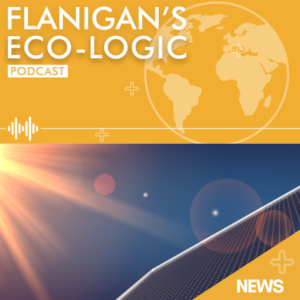
EcoNet News, Volume 25, Issue #1, features an essay on solar power and its vast, largely untapped potential; sustainable aviation fuels; the use of hydrogen for conventional jet engines and in fuel cell configurations; UGES – Underground Gravitational Energy Storage; EV updates on Sony, Tesla in Germany, and Hertz; the Floating Offshore Wind Shot; as well an article on regulating America’s last common form of pollution, cigarette butts and their cellulose acetate filters.

In this episode of Flanigan’s Eco-Logic, Ted speaks with Tucker Perkins, President and CEO of the Propane Education & Research Council.
Tucker unpacks propane, from its sources to its many applications and environmental attributes. He explains its widespread use in over 6 million American homes for heating. It’s not just for barbecues, Zambonis and forklifts! In fact, “Autogas,” as it is called abroad, is used worldwide in cars and buses and trucks.
The U.S. alone has 15 billion gallons a year of excess propane, also known as liquid petroleum gas, which is exported. Unlike natural gas, and its pipelines and distribution system that leaks the highly potent greenhouse gas, methane, propane has no methane, burns clean, and thus we learn, is a preferred fuel in many applications.
